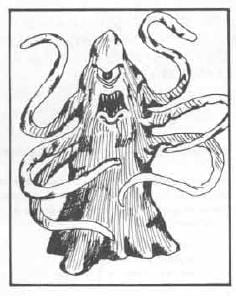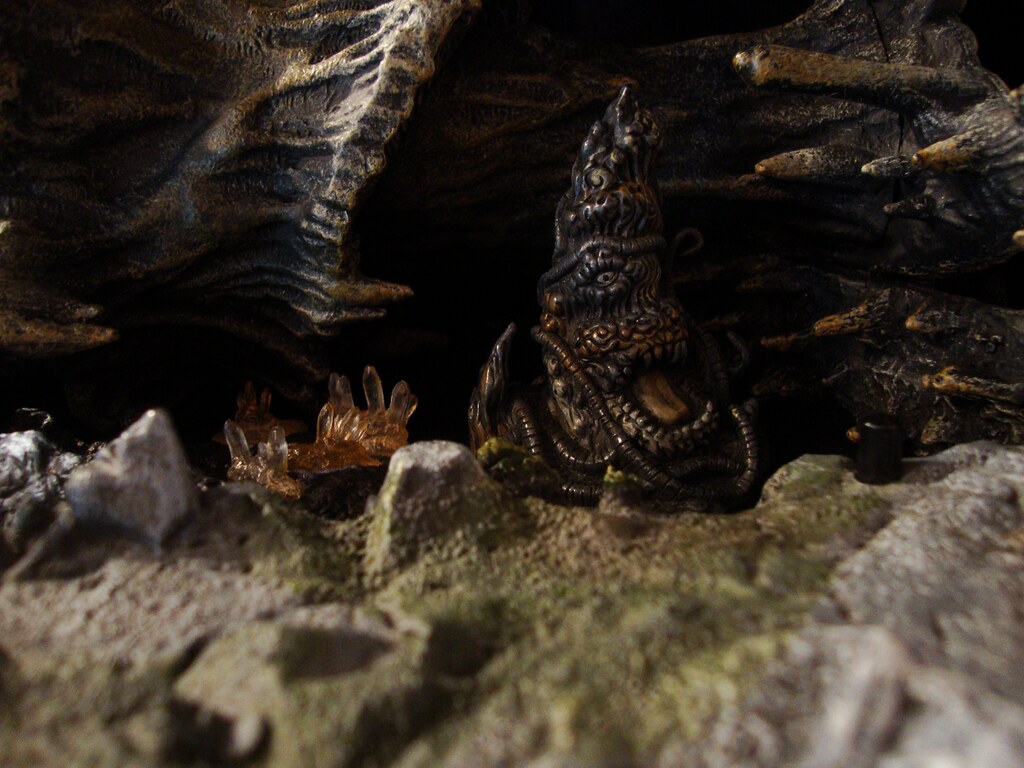D&D Monster Monday: Roper

You offer to scout ahead of the rest of the party in this dank, dark, cave full of stalactites and stalagmites. With sword drawn and torch lit you push ahead until you feel some moisture drop down on your shoulder. Before you can look up you feel rope-like tendrils constrict around your ankles and hoist you towards a triangular creature with a maw of giant teeth. The party doesn’t hear your screams, they only see your disassembled corpse below the roper.
The roper has become a new favorite creature of mine from the Monster Manual (MM). It’s a creature that thrives on surprising its prey and waiting for just the right moment to launch its barrage of attacks.
Just like the drider from a few weeks ago they are from the Underdark. If you’re familiar at all with the Underdark you already know that this is going to be a crazy creature. They’re basically made to fight in the dark or enclosed spaces or else they’d never survive in the harsh world of the Underdark.
Ropers are basically a walking cave formation with a large set of piercing-sharp teeth and tendrils that are made for grappling an enemy far away and pulling them into those teeth. They’re not particularly mobile, but they don’t have to be because their dinner comes to them.
Roper Lore
From the basic description I’ve already given we can tell that a roper is an opportunistic predator. They’ll lash their tendrils out at whatever comes across their path that seems easy enough to grab. An easy meal is a good meal and it’s said that ropers can digest pretty much anything be it creatures or their equipment.
In fact, the list of what a roper can’t digest is much shorter than what it can. Platinum, gems, and magic items are the only things that it cannot digest. These powerful juices are pretty valuable to alchemists because of these properties.
Their triangular appearance with grey-purple coloration makes them look just like a simple cave formation. They can stay so perfectly still that they are unrecognizable from a cave formation because of this. This gives them the perfect opportunity to lash out at any unsuspecting meal crossing its path.

The roper has 6 tendrils that it can lash out to grapple a creature and pull them in to devour them. If a creature is able to break free of its hold and lob off a tendril the roper can quickly regenerate a new one in its place. A creature’s only true way to escape this predator is to run as far away from it as they can.
Ropers are basically just hanging around in caves and waiting for a meal to pass by. They don’t move much or exert much energy so they don’t need to actively hunt for sustenance. They survive simply to eat and exist.
Roper Stats and Abilities
You can find the roper’s statblock on page 261 of the MM.
Basic Stats
- Size: Large
- AC: 20 (natural armor)
- Hit Points: 93 (11d10 + 33)
- Speed: 10 ft., climb 10 ft.
- STR: 18 (+4)
- DEX: 8 (-1)
- Con: 17 (+3)
- INT: 7(-2)
- WIS: 16 (+3)
- CHA: 6 (-2)
Mechanically speaking having a high Strength, Constitution, and Wisdom helps prevent the roper from being moved around or overpowered. This is pretty much required for a creature that relies on grappling enemies to hold on to said enemies. This also makes for a hearty creature in combat that will take a bit of time and effort to dispose of.
Low Intelligence and Charisma are not awful from a mechanical standpoint. There isn’t a lot that can do much harm to a roper using those two saving throws. It also makes sense thematically, it’s a mound of flesh that sits around and eats creatures that run past.
Low Dexterity can be a bit of an issue, but it doesn’t affect its AC that much. 20 AC and 93 Hit Points make for a very tough creature.
Climb speed is nice, but having a total of 10 ft. of movement per round is pretty awful from a mobility standpoint. That being said, the way the roper was made makes their low movement speed inconsequential.
Honestly, the roper is a great example of a low INT high WIS creature. It’s not particularly smart, but it has the practical knowledge of what it can easily kill and what it should hide from. It knows how to survive, but doesn’t know how to solve complex problems.
Resistances, Immunities, Saves, and Skills
- Skills: Perception +6, Stealth +5
- Senses: darkvision 60 ft., passive Perception 16
- Languages: None
- CR: 5 (1,800 XP)
High Stealth and Perception make perfect sense for the creature. The roper sits stealthily in a cave where it waits for a weaker creature to pass by. This also makes it difficult for stealthy characters to sneak past the roper’s every-watching eye.
Interestingly enough, it speaks no languages. This is huge for a lot of spells like Detect Thoughts or any mind-altering spell require a creature to have greater than 3 Intelligence and speak a language.
It’s difficult if not impossible to manipulate a creature that cannot speak. This removes just one way of getting out of a roper’s clutches.

Abilities and Traits
False Appearance. While the roper remains motionless, it is indistinguishable from a normal cave formation, such as a stalagmite.
Grasping Tendrils. The roper can have up to six tendrils at a time. Each tendril can be attacked (AC 20; 10 hit points; immunity to poison and psychic damage). Destroying a tendril deals no damage to the roper, which can extrude a replacement tendril on its next turn. A tendril can also be broken if a creature takes an action and succeeds on a DC 15 Strength check against it.
Spider Climb. The roper can climb difficult surfaces, including upside down on ceilings, without needing to make an ability check.
Grasping Tendrils is fairly necessary to ensure that the roper is still a threat in a long combat encounter. If the party simply lobs off all 6 tendrils the creature would basically become a hunk of flesh with 10 ft. move speed per round with a melee bite attack. DC 15 is a fair check for a CR 5 creature as well.
I absolutely love the combination of False Appearance and Spider Climb. It opens up some verticality in the fight in which a roper could hang from the ceiling and drag its grappled victims up to it. If they drop they may even take some fall damage making the fight a bit more deadly.
Actions
Multiattack. The roper makes four attacks with its tendrils, uses Reel, and makes one attack with its bite.
Bite. Melee Weapon Attack: +7 to hit, reach 5 ft., one target. Hit 22 (4d8 + 4) piercing damage.
Tendril. Melee Weapon Attack: +7 to hit, reach 50 ft., one target. Hit: The target is grappled (escape DC 15). Until the grapple ends, the target is restrained and has disadvantage on Strength checks and Strength saving throws, and the roper can’t use the same tendril on another target.
Reel. The roper pulls each creature grappled by it up to 25 feet straight toward it.
Ropers are the kings of the action economy. They essentially get 5 attacks per turn, though only 1 of them deals damage. However, grappling and restraining up to 4 creatures per turn and 6 creatures total is nothing to scoff at.
Being able to restrain their victims gives the roper advantage on their bite attacks against the creature. A roper can practically restrain an entire adventuring party in 1-2 rounds if it hits all of its attacks.
While they only deal 22 damage per round on average, I’d still say that the roper is a force to be reckoned with. Restrained creatures also have disadvantage on making attacks which gives the roper a bit more survivability. This is a creature that can last quite a long time in a fight.
Roper Strengths
Crowd Control
This practically goes without saying, but the roper is a crowd control machine. It can grapple up to 4 creatures per round at a total of 6 creatures. This by itself is great because now all of those creatures cannot move or maneuver themselves around.
However, Tendril adds a few more elements to a normal grapple. Most importantly, the creature is restrained. A creature grappled by the Tendril also has disadvantage on Strength checks and saving throws meaning that if they try to use Athletics to break the DC 15 grapple they’re doing so at disadvantage. It also takes an Action to try to do this.
With Reel the roper will continue to drag all grappled creatures towards itself so it can make a Bite attack against one of them. This also further displaces the creatures and gives the roper more control over the battlefield.
Between all the grappling and the forced movement, the roper is an excellent creature to pair up with a heavy damage dealing melee creature. This other creature can run between the restrained creatures and make some devastating attacks at advantage with very little fear of retaliation.

Survivability
Ropers are creatures that drag their unsuspecting victims into melee range. Mechanically they need to be pretty beefy to be able to continuously use this tactic. Thankfully they are.
With an AC of 20 they’re already pretty heavily armored compared to most creatures in the MM. 93 HP is also a solid amount for a CR 5 creature, but this isn’t very surprising considering the roper has 17 Constitution. Base stats wise it’s very solid.
Any creature that is restrained by a Tendril attack is at disadvantage to attack. Trying to hit a creature with 20 AC at disadvantage is pretty difficult. So not only is it beneficial for their offensive abilities to grapple as many creatures as they can, doing so also aids in the roper’s survivability.
Spider Climb should also be considered when looking at the roper’s survivability. Being able to hang from the ceiling or climb up walls and avoid melee attackers can give the roper a bit more breathing room in a fight. Though with only 10 ft. of movement speed this might be limited during combat, but they can position themselves in such a place before they engage the party.
Roper Weaknesses
Long-Ranged Attacks
Tendril has a range of 50 ft. which is nothing to scoff at for sure. In fact, it’s pretty great and gives the roper plenty of room to attack multiple targets.
However, if any of the roper’s enemies are outside of that 50 ft. range and can comfortably attack from outside of that range they’re at a major disadvantage.
Not to mention the fact that most spellcasters or ranged attackers will have a movement speed higher than 10 ft. so the roper will never be able to catch up with them as soon as they’re out of the roper’s range.
This is why the roper really needs to wait patiently until everyone is within its range. If anyone is able to get out of range they completely safe from the roper.
Any creature or PC that can get out of range and pepper the roper with ranged attacks is this creature’s nightmare. Don’t let this happen. Caves should be small and confined spaces where it’s difficult to maneuver in.
Being Forcibly Moved
Ironically for a creature that thrives off of forcibly moving others via its grappling tendrils, its weakness is to be forcibly moved. If the roper is hit by a Thunderwave spell or some other ability that pushes the creature back it forces it to release its grapples.
If the roper loses its grapples it becomes much less of a threat. Its enemies can take the opportunity to dash away from the roper so that they can get comfortably out of the creature’s range and hit it from afar.
That being said, ropers have some solid ability scores for most of the movement displacement spells and abilities so this isn’t necessarily a big deal, but it’s still something to keep in mind.
Another issue with being pushed further from its targets is that the roper will have a very rough time trying to catch up with its enemies. Ropers have 10 ft. of movement while the average PC will have 25-30 ft. meaning that they can dash out of the roper’s range once it has been displaced.
How to Play a Roper
Ambush!
A roper waits until the perfect opportunity to strike presents itself. Ideally, it wants all of its potential targets to be within range of its Tendril attack. Anything outside of that is a huge threat that the roper has no tools to deal with.
Getting in a surprise round is crucial for a roper. If the party gets enough time to run out of its range it becomes much less effective. However, if it can lash out of hiding and grapple multiple targets it’s off to a great start in the encounter.
A roper won’t necessarily be waiting in a big open room. They’d probably be found within the tunnels of the cave or in small rooms. They don’t want to be in an open area where a potential meal could have room to escape its grasp.
Strike quickly and grapple as many creatures as you possibly can.

Positioning is Key
Make great use of your Spider Climb and False Appearance to disguise yourself as a cave formation hanging from the ceiling. You gain some extra points if it’s a high ceiling so your unsuspecting victims will take fall damage if they break your grapple.
As a roper, you want to utilize your traits so that you can find yourself a good position to stay out of melee range. The only way a melee attacker is going to get to you is if you drag them to you.
Be in position to control the whole battlefield and don’t give the party easy opportunities to get out of the roper’s range.
Conclusions
I’ve loved ropers since I first used them in The Fasting Worm at the Spider Feast. Using them as traps opened up the floodgates for me in terms of this versatile creature. You can use them as an outright-ambush combat encounter or even as part of a trap!
A roper is a dangerous creature with some excellent Underdark flavors like many of my other favorite creatures. They’re unique and can be a hearty fight in their own right or could simply be part of an encounter with other creatures of the Underdark.
Ropers are great because they are hearty creatures that can take a few creatures out of the fight while their allies make quick work of the few party members lucky enough to not get grabbed and reeled in towards the roper.
Throw some ropers into your next natural cave exploration. They’ll be sure to make your players think twice before rushing past stalactites and stalagmites!

Next time I play a built-at-high-level spellcaster for a game, I’m going to note that any time he goes into a cave he’ll spend a few minutes popping fire bolts off at every single stalactite and stalagmite from 65 feet away.
That’s going to be pretty loud! Might not be ropers you’re worried about after all that commotion!
but if once vanquished.. what can PC’s do with roper hide?